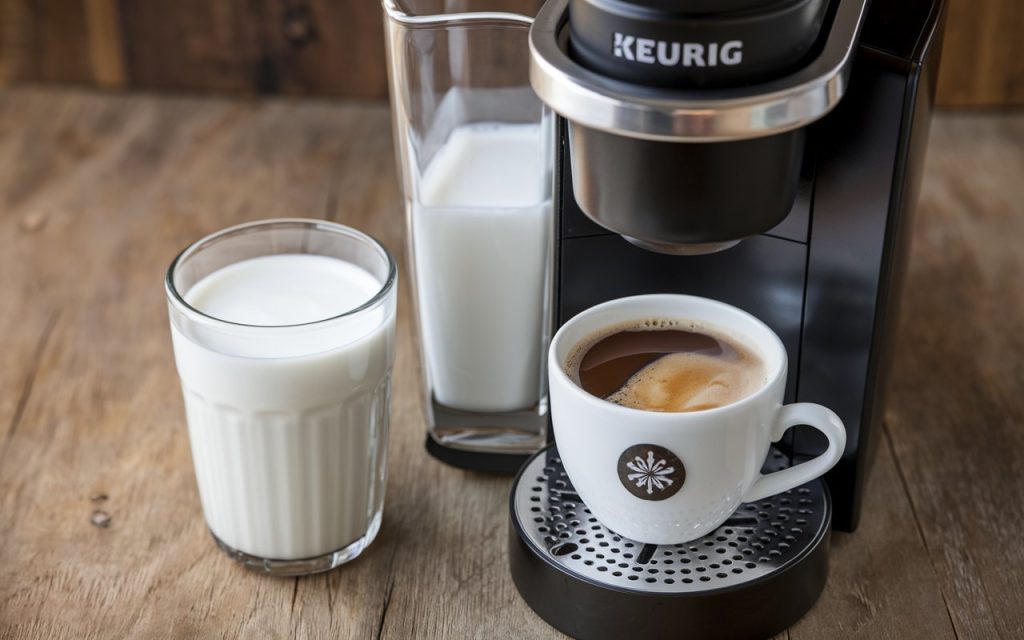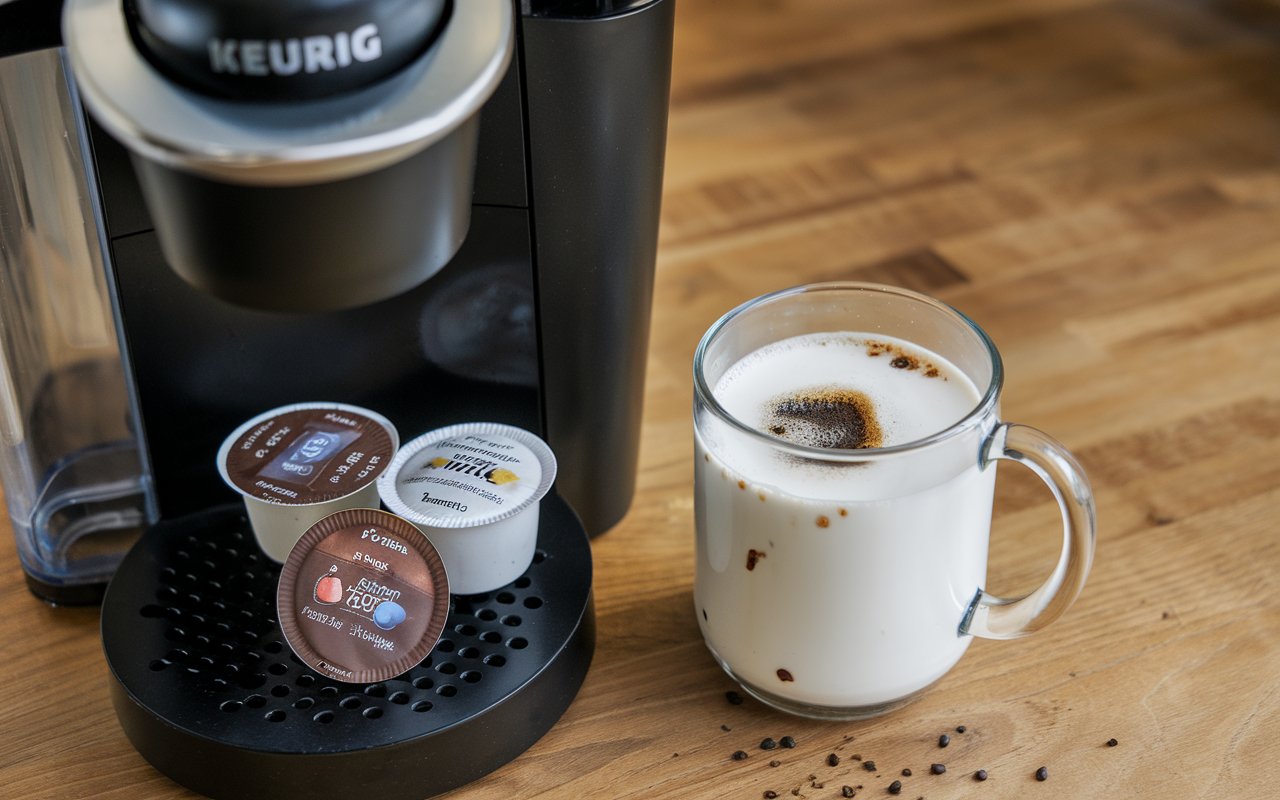Table of Contents
Have you ever wondered if milk could be added to a Keurig? You’re not alone. Many coffee enthusiasts want to learn how to produce creamy coffee drinks with their Keurig machines. In this article, we will explore the exciting perks of using milk with your Keurig and provide clear guidance on how to do it safely. Can you put milk in a Keurig? We will also address common concerns and offer practical tips to enhance your coffee experience.
Understanding Your Keurig Machine

How Keurig Machines Brew Coffee
Keurig machines are known for their simplicity and convenience. They work by using K-cups, which are single-serve coffee pods filled with pre-ground coffee. Hot water is pushed through the pod when you insert a K-cup into the machine and start brewing. Can you put milk in a Keurig? This extracts the coffee and delivers it directly into your cup. The design is meant to make brewing coffee quick and easy without any mess.
What You Can Brew with a Keurig
While Keurigs are most famous for making coffee, they are also versatile. Besides coffee, you can use them to brew tea, hot chocolate, and even some specialty drinks. The variety of K-Cups available means you can enjoy many different flavors and types of beverages. Can you put milk in a Keurig? However, adding milk directly to the machine’s water reservoir is not advisable.
The Milk Question
Can You Put Milk in a Keurig?
The question, “Can you put milk in a Keurig?” ” needs an obvious response: milk shouldn’t be placed straight into the Keurig water reservoir. Milk can spoil and create issues in the machine, such as clogs or unpleasant odors. Instead, it’s better to add milk to your coffee after brewing. This approach helps keep your machine clean and avoids potential damage.
Why Some People Want to Use Milk
Milk is often added to coffee to create a creamy texture and rich flavor. Many people enjoy lattes, cappuccinos, and other milk-based coffee drinks. By adding milk, you can change the taste and texture of your coffee, making it smoother and more enjoyable. Using milk in a Keurig is appealing because it offers a simple way to make these drinks at home.
Benefits of Using Milk in a Keurig
Creamy Coffee Creations
One of the main benefits of adding milk to your coffee is the creaminess it provides. Milk can transform a regular cup of coffee into a creamy latte or a rich cappuccino. This added texture makes your coffee feel more luxurious and satisfying. Adding milk is a great way to enhance your drinking experience if you enjoy a smooth, rich coffee.
Enhanced Flavor Profiles
Milk can also improve the flavor profile of your coffee. It helps balance the bitterness of strong coffee and adds a subtle sweetness. Different types of milk, like whole milk, skim milk, or plant-based options like almond or oat milk, can offer unique flavors and textures. Experimenting with these options allows you to find the perfect combination that suits your taste.
Risks and Considerations
Possible Damage to Your Keurig
Although milk isn’t harmful, placing it directly into Keurig’s water reservoir can lead to problems. Milk can spoil, curdle, or cause residue buildup, creating a mess and potentially damaging your machine. Always use clean water in the reservoir to avoid these issues, and add milk to your coffee after brewing.
Cleaning and Maintenance Concerns
If milk accidentally gets into your Keurig, it’s essential to clean it thoroughly. Milk residue can lead to mold and bacteria growth, affecting your beverages’ taste and safety. Regular cleaning of your Keurig is crucial, mainly if you use milk or other non-water ingredients. Follow the manufacturer’s cleaning instructions to keep your machine in good working order.
How to Use Milk Safely in a Keurig

Step-by-Step Guide
- Brew Coffee First: Start by brewing a cup of coffee with water. This will serve as the base for adding milk.
- Heat Milk Separately: Heat your milk on the stove or microwave. Ensure it’s hot but not boiling. Please avoid using Keurig to heat milk, as it is not designed for this purpose.
- Add Milk to Coffee: Once your coffee is brewed, pour the heated milk into your cup. You can use a milk frother before adding it to your coffee for a frothy texture.
Tips for Best Results
- Use Fresh Milk: Always use fresh milk to ensure the best taste and avoid spoilage.
- Preheat Your Mug: Preheating your mug can help maintain the temperature of your coffee.
- Try Different Types of Milk: Experiment with different types of milk, such as almond, soy, or oat milk, to find the flavor and texture you like best.
Common Questions About Using Milk in a Keurig
Can I Use Milk Instead of Water in the Reservoir?
No, you should not use milk in the Keurig reservoir. Milk can spoil and create a residue that may damage your machine. Always use water in the reservoir and add milk to your coffee after brewing.
What Happens If I Accidentally Put Milk in the Reservoir?
If milk gets into the reservoir, clean the machine immediately. Milk residue can lead to mold and bacteria growth, affecting the taste and safety of your coffee. Follow the cleaning instructions provided by the manufacturer to prevent any long-term damage.
How Do I Keep My Keurig Clean When Using Milk?
Always use water in the reservoir to keep your Keurig clean, and add milk separately. Regularly clean your machine according to the manufacturer’s instructions to prevent buildup and maintain its performance. Click here for more information about Food.
To sum up, can you put milk in a Keurig? While you can’t put milk directly into the machine’s water reservoir, you can still enjoy the benefits of milk in your coffee. You can create delicious, creamy beverages without damaging your Keurig by brewing your coffee with water and then adding heated dairy. This method allows you to savor various coffee drinks, from lattes to cappuccinos, while keeping your machine in excellent condition.




